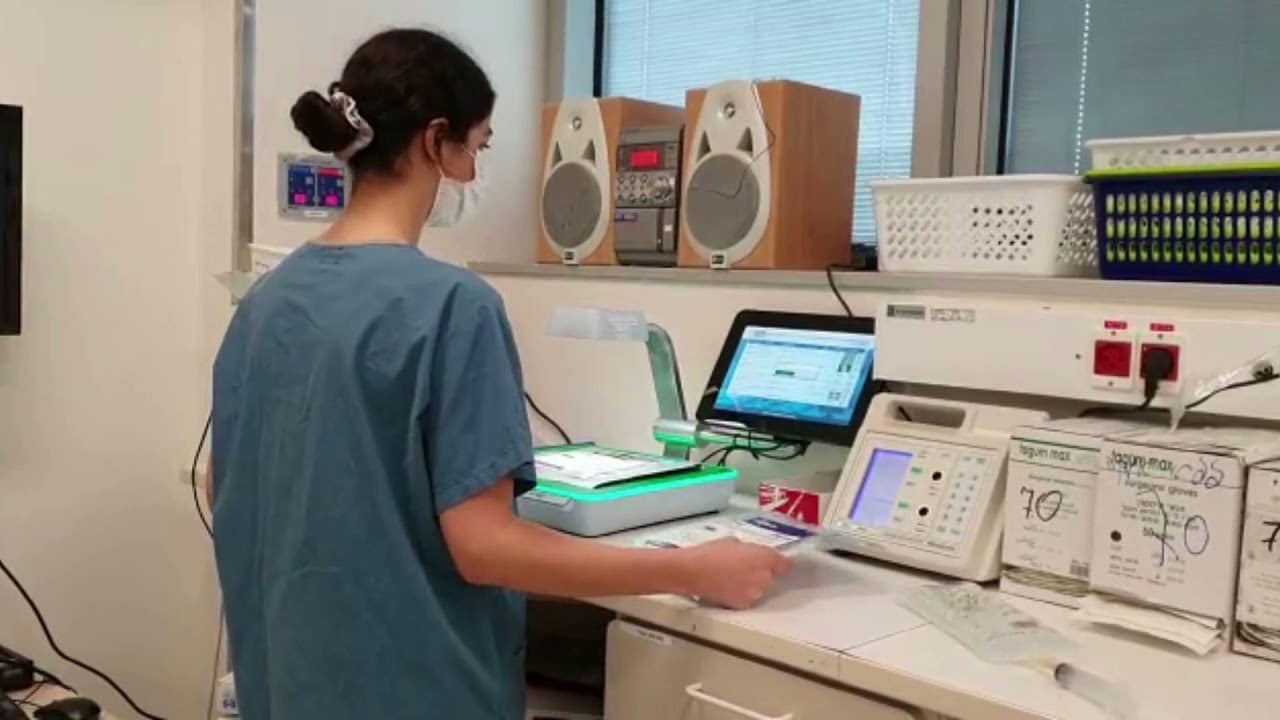What’s inside:
Discover the key indicators of charge capture issues in the OR, why they lead to revenue loss, and how proactive strategies and modern documentation technology can help hospitals close gaps and improve efficiency.
You’ll learn how to:
- Identify common charge capture challenges
- Recognize the red flags in OR documentation
- Improve accuracy at the point of care
- Protect revenue and streamline workflows
There’s a clear giveaway, a red flag, that signals an organization is struggling with surgical supply charge capture.
But before we get to that, let’s examine your current OR supply documentation process. Is your charge capture truly watertight?
If your point-of-use perioperative documentation tools fail to accurately record every consumed, billable item, then your charge capture process, and the technology behind it, requires urgent review.
Before revealing the red flag that signals your organization has OR data collection issues, let’s outline the fundamentals.
The Hidden Financial Impact of Poor OR Charge Capture
When it comes down to the basics, healthcare organizations are high-performance businesses. Strong margins and operational discipline are essential to perform well in a challenging and competitive sector.
Charge capture, the accurate documentation and billing of every supply, implant, and device used, is the financial lifeblood of your OR. Yet, despite its significance, many hospitals grapple with data collection challenges in the high-pressure surgical environments, particularly operating rooms and procedural areas.
Poor surgical supply documentation costs US hospitals $7.7 billion annually.
The challenge is widespread, but it also represents one of the single largest opportunities for immediate margin improvement.
Customer feedback suggests that addressing charge capture inefficiencies can yield a substantial increase in reimbursement, with potential gains ranging from 10% to 30%. This represents a substantial boost to the financial health of healthcare organizations, making it a priority area for those seeking to enhance their margins and boost their competitive edge.
Forward-thinking healthcare organizations are now taking proactive steps to prioritize charge capture integrity to protect revenue, enhance operational performance, and safeguard long-term financial health.
Charge Capture in the OR, Simplified
To understand why OR charge capture fails, and how it can be fixed, it helps to break the problem into three fundamentals:
- Why charge capture matters financially
- Where perioperative workflows break down
- Why legacy OR documentation technology cannot keep up
Why Charge Capture Matters in the OR
With healthcare finance, every detail counts, especially when it comes to high-value medical implants. These vital items represent a significant investment for hospitals and ambulatory surgery centers, so ensuring full oversight in the accurate documentation of these implants can have a significant financial impact. When high-value items are missed from medical billing or the provider undercharges for them, this has a direct implication on the bottom line. Achieving charge capture integrity in surgery is therefore vital for optimized medical billing and case revenue.
Ensuring charge capture integrity in surgical procedures is paramount for optimizing medical billing and maximizing case revenue. By meticulously recording every billable item used during surgery, healthcare providers can avoid revenue leakage and discrepancies in billing. Additionally, accurate charge capture enhances transparency in financial transactions, fosters trust among stakeholders, and upholds compliance with regulatory requirements.
But the financial implications extend beyond individual procedures. In a landscape where healthcare reimbursement models are increasingly tied to outcomes and value-based care, precise charge capture becomes even more critical. Proper documentation of medical implants not only safeguards revenue streams but also contributes to demonstrating the true cost-effectiveness and quality of care provided by healthcare institutions.
Overall, charge capture integrity serves as the cornerstone of financial health and operational efficiency, so creating robust charge capture processes will improve healthcare performance.
Operational Realities Behind Charge Capture Failures
It’s not easy. Precise supply documentation in surgeries is no small feat. Missed items, incorrect entries, and incomplete EHR records are a common outcome of inadequate systems that fail to achieve the task they were designed to tackle.
Achieving precise supply documentation within surgical settings presents a challenge. The high-pressure environment of operating rooms demands that the circulating nurse, who is responsible for documenting charge capture, prioritizes the tasks of supporting the patient and the clinical team. The complex job of meticulously and accurately entering product details into the system can be hard to achieve amid the flurry of patient-centered activity.
Unfortunately, inadequate point-of-use systems often exacerbate this challenge, leading to even further complications, such as missed items, incorrect entries, and incomplete records. Despite the best intentions, these shortcomings hinder healthcare providers’ ability to effectively capture and document every aspect of surgical supply utilization.
So, the sheer effort involved in correctly capturing product information and charges at the point of care is actually compounded by the very systems designed to streamline operations and enhance efficiency. When technology falls short, healthcare teams then have to deal with the repercussions of inaccurate supply utilization documentation, which often involves resorting to inefficient and manual workflows.
Why Traditional Data Capture Technology Can’t Keep Up
Inefficient data collection tools for perioperative documentation not only elongate workflows but also divert valuable attention away from patient care, leading to heightened levels of frustration among healthcare professionals and can adversely affect nurse job satisfaction, patient outcomes, and organizational performance.
Perioperative documentation aims to achieve full charting and charge capture, yet despite concerted efforts, operating rooms from coast to coast continue to grapple with the challenge of maintaining data integrity throughout the surgical supply documentation process.
The limitations of traditional data capture technologies have become increasingly apparent in this context. Outdated systems often lack the agility and adaptability required to keep pace with the demands of modern healthcare delivery. Cumbersome interfaces, ineffective scanners, manual data entry requirements, and compatibility issues further exacerbate the challenges, impeding the seamless flow of information and hindering clinicians’ ability to provide timely and correct surgical records.
Full charting and full charge capture may be the goal, but traditional tech falls short.
The Top Red Flag of Inefficient OR Supply Documentation
One unmistakable sign that an organization has charge capture issues: frantic post-surgery documentation and reconciliation.
When hospitals rely heavily on reviewing, correcting, or reconstructing OR records after the case, it signals a lack of trust in point-of-care data.
This reactive workflow causes a domino reaction that takes valuable time from perioperative leadership, supply chain teams, revenue integrity staff, and nurses, while creating frustration and pulling focus away from strategic priorities.
Reactive Workflows Drain Resources and Reduce Accuracy
But reactive management is resource-heavy and exhausting.
Why are hospitals having to take steps to mitigate the shortcomings of inadequate OR data capture tools?
Surely, it’s time for more proactive management strategies to achieve better data integrity at the point of care, resulting in a patient file that reflects supply consumption by the end of surgery, without the need for any additional data entry, scanning, reviewing, or reconciling.
By adopting proactive measures such as implementing advanced point-of-use technology, hospitals can empower their staff to deliver optimal patient care while ensuring the integrity and accuracy of OR records from the outset.

With the failure of current systems, healthcare providers are increasingly turning to innovative data capture technologies to upgrade their perioperative documentation capabilities.
There is now an understanding that evolving technology may be the key to bridging the gap between clinical care and administrative processes.
Next-generation data capture technologies can finally transform OR supply documentation into a quick and efficient task.
So, let’s look at the leading solution on the market.
AI-Powered Charge Capture for Automated Point-of-Use Documentation
Snap&Go is a next-gen utilization and charge capture tool that achieves full data collection during surgery – including traditionally “tricky” items such as off-contract products, bill-only implants, surgery kits, and small, loose orthopedic nuts, bolts, screws, and plates.
What does that look like?
- 100% reporting
- 100% charge capture
- For EVERY reportable and billable item
In short, Snap&Go delivers instant, accurate supply utilization records during surgery, without the need for any additional activity.
Camera vision, machine learning, and AI technology allow clinicians to capture and document the usage of all reportable, billable medical supplies and implants in surgery by simply taking a photo of the item’s packaging or label.
Once the nurse has taken a ‘snap’ of the product, that’s the end of their supply documentation activity. The system automatically:
- Identifies the product
- Undertakes any necessary data fixing
- Verifies the item to support patient safety
- Documents the item straight into the EHR

The Proven Advantages of Computer Vision Charge Capture
The starting point of fixing a broken surgical supply documentation system is to ensure that OR data capture tools are effective. This is the crucial raw data that you need to get right for the remainder of the process to be effective.
Image-to-data technology offers several benefits for charge capture and documentation in the OR:
▶ Efficiency: By eliminating the need for manual data entry, image recognition technology streamlines the charge capture process, saving clinicians time and reducing the risk of errors.
▶ Accuracy: The advanced algorithms used in image recognition technology ensure accurate capture and documentation of medical supply usage, minimizing discrepancies and improving billing accuracy.
▶ Convenience: Clinicians can easily capture images of supplies using the Snap&Go computer sensor, allowing for seamless integration into existing workflow processes without disrupting surgical procedures.
▶ Real-time Updates: Image recognition technology provides real-time updates to the EHR, allowing healthcare facilities to achieve accurate supply usage records on the spot, without the need for any exhausting post-surgery chasing around.
▶ Reimbursement: When supply utilization and charge capture are optimized, case revenue is maximized.
Read our Orthopedic Surgery Charge Capture Case Study to see how one health system uncovered 127% more billable value using advanced computer vision in the OR.
Snap&Go tackles OR data-capture issues head-on by enhancing charge capture and supply utilization documentation in the OR, enabling healthcare organizations to optimize OR revenue, improve operational efficiency, and enhance patient care quality.
Leveraging new technology can finally achieve precision charting and charge capture, without all that running around.
It’s time to join the image-to-data revolution.
Ready to Fix Charge Capture in Your OR? See how much revenue your OR could be recovering with accurate, automated charge capture.
Contact us to unlock your OR revenue today.






